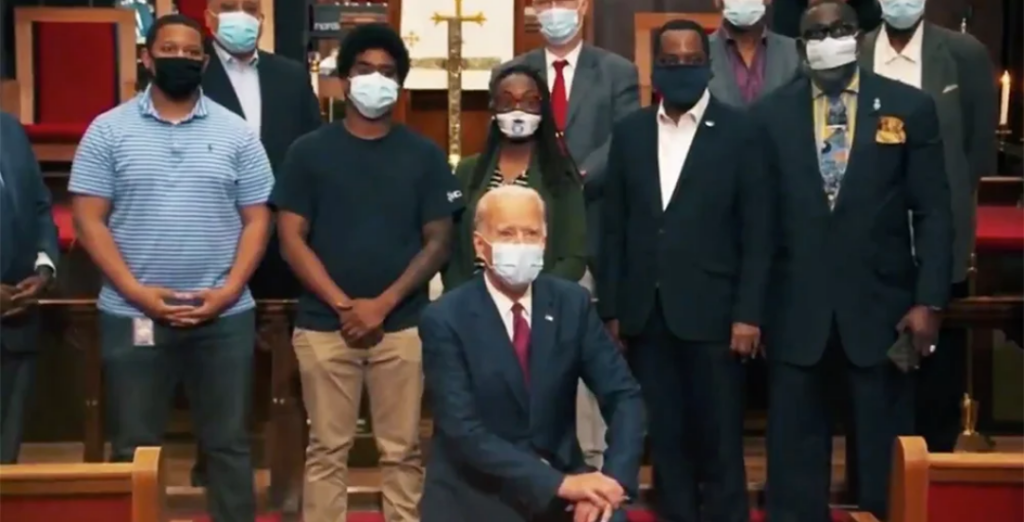What do you see in this photo?

At the literal level, here’s what I see: a White presidential candidate kneeling in front of half a dozen Black men, at least one Black woman, and another White man. I see pews and a crucifix, so I assume that this is in a church, probably a Black church. It looks like a standard presidential campaign photo opportunity. I do wish they had practiced adequate social distancing, to set a good example.
As it turns out, according to Religion News Service (RNS), this is a video still from a video taken when Joe Biden visited Bethel African Methodist Episcopal Church in Wilmington, Del., not long after the death of George Floyd. According to RNS, Biden was at the church to talk about “racial injustice and police brutality before praying with those assembled.” So my literal reading of the photo wasn’t far wrong.
Campaign staffers for the Donald Trump presidential campaign would like to have you see this image in a different light. RNS reports that this video clip has been used to conclude a Trump campaign video which equates Joe Biden with civil unrest. I didn’t have the stomach to watch the video myself, so I will trust RNS when they tell me that immediately following the video clip showing Biden in a Black church, “words appear on the screen reading ‘stop Joe Biden and his rioters’ as Mike Pence declares ‘you won’t be safe in Joe Biden’s America’.”
Thus it appears that what the Trump campaign staffers who created this ad would have you see is something rather different from what I saw. It appears that what they want you to see is that Joe Biden and Black church leaders are dangerous. However, when the RNS asked this question of Donald Trump’s press secretary, this interpretation was categorically denied:
“Asked whether the ad meant to suggest there was something unsafe about Black churches or meeting with Black leaders in a church, Trump campaign deputy national press secretary Samantha Zager replied, ‘That’s absurd and it’s shameful to even make the allegation.’ When Religion News Service followed up to ask what, exactly, footage of the church visit was meant to imply, Zager did not respond.”
In spite of Zager’s denial, it’s clear to me that the intent of this advertisement is to allow people to complete an equation in their mind: dangerous rioters equals the Black church equals Joe Biden. There is also a clear effort to equate Joe Biden with rioters, and with those athletes who kneel during the national anthem. It also seems likely that this advertisement wants to imply that this White man, Joe Biden, will kneel down before Black men and women.
I had quite a few years of training in the visual arts, and I’m always impressed at the multi-layered messages that visuals in political campaign ads can evoke. And I’m cynical enough that it doesn’t surprise me that the Tump campaign is using racial fears to motivate voters; American politicians have been doing that for centuries now, often with great effect; why would a politician who’s hungry to be re-elected give up a tried-and-true campaign strategy?
But I am troubled that a good portion of the American electorate is still so susceptible to political manipulation through their racial fears that it makes it worth the while of unscrupulous politicians to manipulate the emotions of susceptible voters in this way. Someone thinks this may be a winning strategy for the Trump campaign, and they may well be right. All the elegant theories of White privilege and White fragility and White supremacy — these theories haven’t change the emotional make-up of a great many White Americans. Anyone with training in the visual arts knows that a few well-crafted images can easily bypass the most elegant of theories….
I suspect there’s a role here for artists, illustrators, film makers, video game designers, and other visually skilled people. The visual impact of a movie like “Black Panther” may make more of a difference than your average street protest. There may be a role for amateur artists, too, in flooding the interwebs with imagery that equates Black Americans with patriotism, honor, intelligence, serving the public good, and other politically positive messages.
